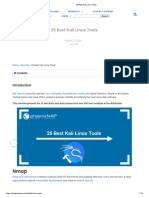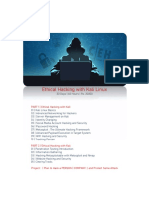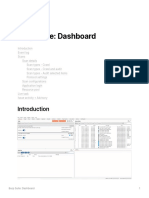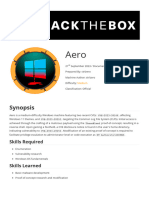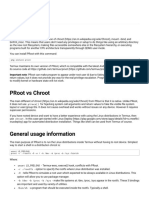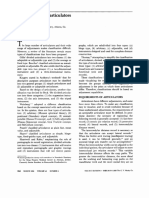Metasploit - Tutorial Part.1
Uploaded by
seyi0Metasploit - Tutorial Part.1
Uploaded by
seyi0P a g e |1
Metasploit tutorial part 1: Inside the Metasploit framework
Karthik R, Contributor
You can read the original story here, on SearchSecurity.in. The Metasploit Framework (Msf) is a free, open source penetration testing solution developed by the open source community and Rapid7. This Metasploit tutorial covers the basic structure of Metasploit and different techniques of information gathering and vulnerability scans using this tool. Metasploit eliminates the need for writing of individual exploits, thus saving considerable time and effort. The use of Metasploit ranges from defending your own systems by breaking into them, to learning about vulnerabilities that pose a real risk. Download Metasploit from http://www.metasploit.com to maximize the learning from this metasploit tutorial.
Figure 1. Metasploit architecture (Courtesy Rapid7)
http://searchsecurity.techtarget.in/tip/Metasploit-tutorial-part-1-Inside-the-Metasploit-framework
P a g e |2
Useful terminology: Vulnerability: A weakness in the target system, through which penetration can successfully occur. Exploit: Once a vulnerability is known, an attacker takes advantage of it, and breaks into the system using a code/script known as an exploit. Payload: This is a set of tasks initiated by the attacker subsequent to an exploit, in order to maintain access to the compromised system.
After installation, it is easy to figure out the file system and libraries, as the naming convention used is self-explanatory and intuitive. Metasploit is based on scripting language, so the script folder contains meterpreter and other scripts required by the framework. Metasploit offers a GUI version, as well as a command line version. All features are accessible via the command line utility, but some users might prefer the GUI. Getting started To kick off this Metasploit tutorial, let us skim through basic footprinting and vulnerability scanning using this tool, before getting into basic exploitation.
Metasploit has good provisions for information gathering and vulnerability scanning, due to its integration with the dradis framework and configuration with various database drivers such as mysql, sqlite and postgresql. This is detailed in Figure 2.
Figure 2. Database configuration in MSF3 console on Backtrack4
http://searchsecurity.techtarget.in/tip/Metasploit-tutorial-part-1-Inside-the-Metasploit-framework
P a g e |3
Figure 3. Using Nmap within Msf console, in Backtrack4
The Nmap command can be used to perform service scans and information gathering using Msf3 as shown in Figure 3. Nmap can be replaced with the db_nmap command in order to connect to the database and store the information. Next in this Metasploit tutorial comes vulnerability assessment, using the bridge between Nessus and Msf3 in Backtrack. For a new scan with Nessus, use the nessus_scan_new command in the console. Before doing this, as seen in Figure 4, nessus_connect is used to connect to the nessus server running, once the credentials have been saved post-setup.
http://searchsecurity.techtarget.in/tip/Metasploit-tutorial-part-1-Inside-the-Metasploit-framework
P a g e |4
Figure 4. Using Nessus bridge with Metasploit, in Backtrack4
The next step in this Metasploit tutorial gets into actual exploitations using Metasploit. Let us attempt to exploit a system on Windows XP with RPC DCOM vulnerability with an attacker system running Metasploit. The lab setup includes a Windows XP attacker system with Metasploit framework installed and a Windows XP vulnerable system, both on VMware. The command search dcom seen on the console will list out all the exploits available with pattern dcom. We are interested in the result displayed as Microsoft RPC DCOM Interface overflow. Next, in the console type >> use windows/dcerpc/ms03_026_dcom followed by >> show options
Figure 5: Metasploit console
http://searchsecurity.techtarget.in/tip/Metasploit-tutorial-part-1-Inside-the-Metasploit-framework
P a g e |5
Figure 6. Options available in the RPC DCOM exploit
Then use the following command to set the target as well as the payload. >> set RHOST 192.168.1.2
Figure 7. Console after setting payload, showing the required module and payload details
http://searchsecurity.techtarget.in/tip/Metasploit-tutorial-part-1-Inside-the-Metasploit-framework
P a g e |6
This sets up our target systems IP address where we would like to perform t his attack. The next command is: >>set PAYLOAD windows/adduser
Figure 8.Executing the exploit
This payload adds a new user account to a Windows machine vulnerable to this exploit. This Metasploit tutorial shows only one payload in action here; you can try out various other payloads available here. In console the type>> exploit
Figure 9. A new user metasploit is created
http://searchsecurity.techtarget.in/tip/Metasploit-tutorial-part-1-Inside-the-Metasploit-framework
P a g e |7
No session is created in this exploit; only a new user is added to the target system. The target system has not had a remote crash, because the exploits here are tested to ensure that no crash occurs. Now, check if the new user metasploit is created in the target system. In the first part of this Metasploit tutorial, the above exploit is applicable during that phase of pen testing when a user needs to be created to gain access to the target system and escalate privileges.
Authors note: This Metasploit tutorial series starts from the basics and gradually moves on to advanced topics such as evading antivirus software with the Metasploit Framework. The information herein draws from Metasploit Unleashed (http://www.offensive-security.com) and select video clips from Vivek Ramachandra, the founder of SecurityTube. About the author: Karthik R is a member of the NULL community. Karthik completed his training for EC-council CEH in December 2010, and is at present pursuing his final year of B.Tech in Information Technology, from National Institute of Technology, Surathkal. Karthik can be contacted on rkarthik.poojary@gmail.com. He blogs at http://www.epsilonlambda.wordpress.co You can subscribe to our twitter feed at @SearchSecIN. You can read the
original story here, on SearchSecurity.in.
http://searchsecurity.techtarget.in/tip/Metasploit-tutorial-part-1-Inside-the-Metasploit-framework
You might also like
- AndroGoat Application Vulnerability AssessmentNo ratings yetAndroGoat Application Vulnerability Assessment14 pages
- Metasploit Meterpreter Webcam - List Webcam - Snap Record - Mic - Eric Romang BlogNo ratings yetMetasploit Meterpreter Webcam - List Webcam - Snap Record - Mic - Eric Romang Blog6 pages
- Metasploit: Metasploit Is An Exploitation FrameworkNo ratings yetMetasploit: Metasploit Is An Exploitation Framework4 pages
- Use of Metasploit Framework in Kali Linux: April 2015100% (1)Use of Metasploit Framework in Kali Linux: April 20159 pages
- Lab 6 - MITM With Ettercap - ARP PoisoningNo ratings yetLab 6 - MITM With Ettercap - ARP Poisoning1 page
- Tutorial To Setup A Metasploitable and Kali LinuxNo ratings yetTutorial To Setup A Metasploitable and Kali Linux9 pages
- Comprehensive Guide On Cupp - A Wordlist Generating ToolNo ratings yetComprehensive Guide On Cupp - A Wordlist Generating Tool12 pages
- Linux: Setup A Transparent Proxy With Squid in Three Easy StepsNo ratings yetLinux: Setup A Transparent Proxy With Squid in Three Easy Steps11 pages
- 05 - Password Cracking & Gaining Remote Access - OphCrack and Armitage - TestedNo ratings yet05 - Password Cracking & Gaining Remote Access - OphCrack and Armitage - Tested11 pages
- Command Execution - DVWA: Penetration Testing Lab0% (1)Command Execution - DVWA: Penetration Testing Lab8 pages
- Lab 8 - Gaining Access of Metasploitable Machine Using Metasploit FrameworkNo ratings yetLab 8 - Gaining Access of Metasploitable Machine Using Metasploit Framework1 page
- The Art of Penetration Testing a Practical Guide50% (2)The Art of Penetration Testing a Practical Guide221 pages
- HACKING WITH KALI LINUX: A Practical Guide to Ethical Hacking and Penetration Testing (2024 Novice Crash Course)From EverandHACKING WITH KALI LINUX: A Practical Guide to Ethical Hacking and Penetration Testing (2024 Novice Crash Course)No ratings yet
- 3D Bioprinting From Benches To Translational ApplicationsNo ratings yet3D Bioprinting From Benches To Translational Applications47 pages
- Intended Learning Outcome: Life Performance Outcome (LPO)No ratings yetIntended Learning Outcome: Life Performance Outcome (LPO)6 pages
- Musuko Ga Kawaikute Shikataganai Mazoku No Hahaoya Vol.9 Chapter 200 Successor - ManganeloNo ratings yetMusuko Ga Kawaikute Shikataganai Mazoku No Hahaoya Vol.9 Chapter 200 Successor - Manganelo1 page
- Brief Exercises BE2 - 1: No. Account (A) Debit Effect (B) Credit Effect (C) Normal Balance83% (6)Brief Exercises BE2 - 1: No. Account (A) Debit Effect (B) Credit Effect (C) Normal Balance6 pages
- Help Children Be Grateful Pray-Ers: NovemberNo ratings yetHelp Children Be Grateful Pray-Ers: November4 pages
- WWW - Yoquieroaprobar.es: Elementary Test - 1100% (1)WWW - Yoquieroaprobar.es: Elementary Test - 130 pages
- Present Simple or Present Continuous 2018No ratings yetPresent Simple or Present Continuous 20181 page
- Classification of Articulators: Awni Rihani, D.D.S., M.Sc.No ratings yetClassification of Articulators: Awni Rihani, D.D.S., M.Sc.4 pages
- Advantages and Disadvantages of TechnologyNo ratings yetAdvantages and Disadvantages of Technology1 page
- FS5 Field Study Learning Episode: The K To 12 Grading SystemNo ratings yetFS5 Field Study Learning Episode: The K To 12 Grading System9 pages
- Almeida Theatre Production of Homecoming by PinterNo ratings yetAlmeida Theatre Production of Homecoming by Pinter34 pages
- Kenneth Foner - Getting A Quick Fix On ComonadsNo ratings yetKenneth Foner - Getting A Quick Fix On Comonads12 pages
- Metasploit Meterpreter Webcam - List Webcam - Snap Record - Mic - Eric Romang BlogMetasploit Meterpreter Webcam - List Webcam - Snap Record - Mic - Eric Romang Blog
- Metasploit: Metasploit Is An Exploitation FrameworkMetasploit: Metasploit Is An Exploitation Framework
- Use of Metasploit Framework in Kali Linux: April 2015Use of Metasploit Framework in Kali Linux: April 2015
- Comprehensive Guide On Cupp - A Wordlist Generating ToolComprehensive Guide On Cupp - A Wordlist Generating Tool
- Linux: Setup A Transparent Proxy With Squid in Three Easy StepsLinux: Setup A Transparent Proxy With Squid in Three Easy Steps
- 05 - Password Cracking & Gaining Remote Access - OphCrack and Armitage - Tested05 - Password Cracking & Gaining Remote Access - OphCrack and Armitage - Tested
- Lab 8 - Gaining Access of Metasploitable Machine Using Metasploit FrameworkLab 8 - Gaining Access of Metasploitable Machine Using Metasploit Framework
- Certified Ethical Hacker C.E.H v11 Exam Prep And DumpsFrom EverandCertified Ethical Hacker C.E.H v11 Exam Prep And Dumps
- HACKING WITH KALI LINUX: A Practical Guide to Ethical Hacking and Penetration Testing (2024 Novice Crash Course)From EverandHACKING WITH KALI LINUX: A Practical Guide to Ethical Hacking and Penetration Testing (2024 Novice Crash Course)
- 3D Bioprinting From Benches To Translational Applications3D Bioprinting From Benches To Translational Applications
- Intended Learning Outcome: Life Performance Outcome (LPO)Intended Learning Outcome: Life Performance Outcome (LPO)
- Musuko Ga Kawaikute Shikataganai Mazoku No Hahaoya Vol.9 Chapter 200 Successor - ManganeloMusuko Ga Kawaikute Shikataganai Mazoku No Hahaoya Vol.9 Chapter 200 Successor - Manganelo
- Brief Exercises BE2 - 1: No. Account (A) Debit Effect (B) Credit Effect (C) Normal BalanceBrief Exercises BE2 - 1: No. Account (A) Debit Effect (B) Credit Effect (C) Normal Balance
- Classification of Articulators: Awni Rihani, D.D.S., M.Sc.Classification of Articulators: Awni Rihani, D.D.S., M.Sc.
- FS5 Field Study Learning Episode: The K To 12 Grading SystemFS5 Field Study Learning Episode: The K To 12 Grading System
- Almeida Theatre Production of Homecoming by PinterAlmeida Theatre Production of Homecoming by Pinter

